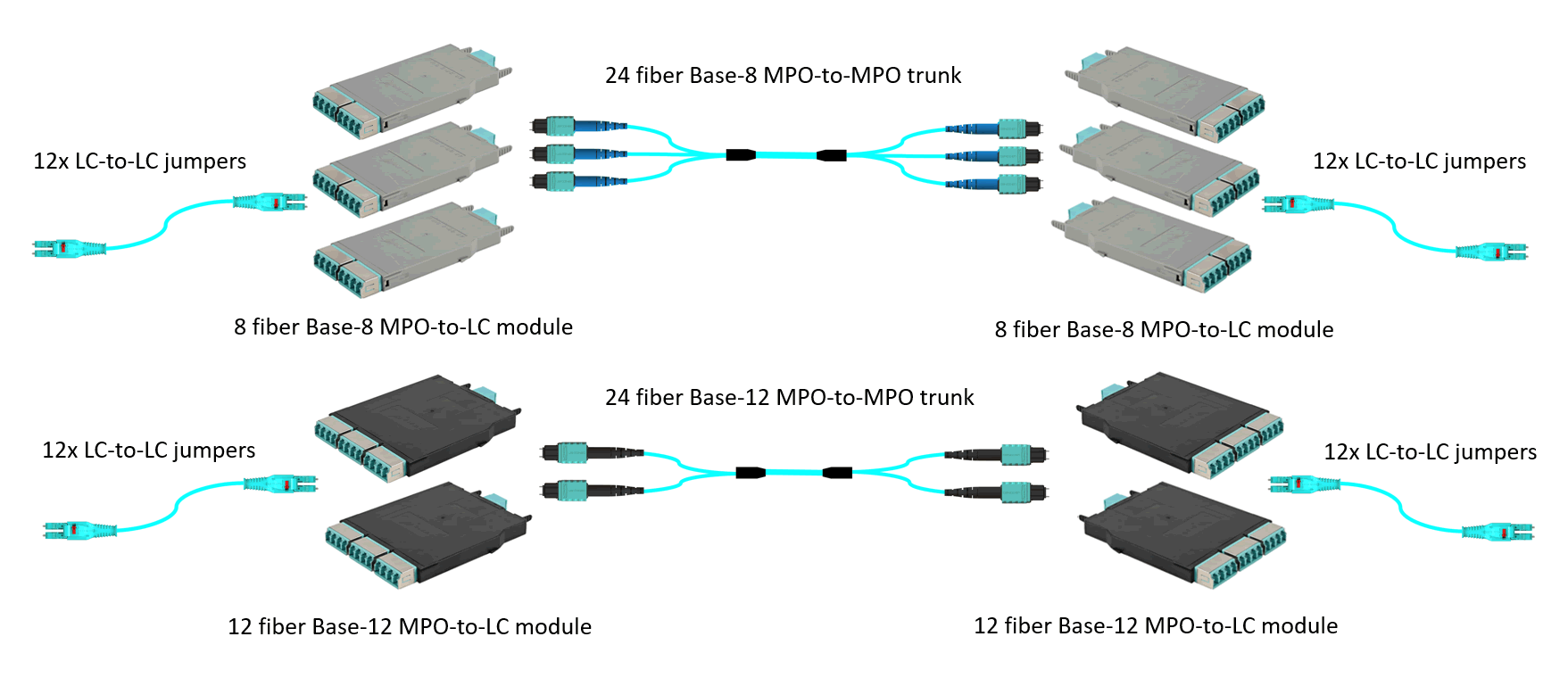At Siemon, we often hear from data center operators asking, “What’s the difference between Base-8 and Base-12 fiber cabling systems?” Essentially, Base-8 products are designed for 8-fiber optical transceivers (and future 16-fiber upgrades), while Base-12 solutions (also compatible with 8-fiber applications) are built for optics that use two fibers.

However, it’s more than just supporting different optics. A structured cabling system needs flexibility to accommodate various optics in switches, servers, or nodes throughout its lifecycle.
While initially introduced with 40GBASE-SR4 (IEEE 802.3ba™-2010), the need for more than 2-fiber or duplex optics in data centers gained momentum with the release of 100GBASE-SR4 (IEEE 802.3bm™-2015). This Ethernet standard introduced 40 and 100 Gb/s speeds using 8 fibers. These higher fiber count optics are also known as parallel optics, and their systems are called array systems. Therefore, a structured fiber cabling system should be capable of supporting both duplex and parallel optics.
Figure 1 shows the three most common MPO connector types. An 8-fiber application can use an MPO-12 connector, but the center 4 fibers are inactive and don’t transmit or receive light signals. It’s important to note that the MPO-16 is a recent addition to the market for supporting 16-fiber applications. Its offset key prevents it from accidentally plugging into optics or adapters with center keys, like the MPO-8 or MPO-12.
 Figure 1: MPO Connector Types
Figure 1: MPO Connector Types
Common data center fiber channels use five basic components: MPO trunks, MPO-to-LC modules or adapter plates, jumpers, and panels or enclosures. The MPO trunk is installed between the MPO-to-LC modules or adapter plates mounted in panels or enclosures on each end, with jumpers connecting the cabling system to the optics.
The advantage of structured cabling is that the MPO trunk remains stationary, often installed in conveyance systems (like cable trays) throughout the data center. Figure 2 illustrates an array fiber channel supporting duplex optics on each end using LC jumpers (multimode shown for reference). Note that a Base-8 trunk has three MPO connectors, while a Base-12 trunk has only two.

Figure 2: 24 Fiber Base-8 and Base-12 Duplex Channels
The Base-8 MPO trunk and MPO-to-LC modules have 24 fibers: 3 MPO connectors x 8 fibers per connector = 24 fibers. The Base-12 channel also has 24 fibers: 2 MPO connectors x 12 fibers per connector = 24 fibers.
Both products utilize 24 fibers, but the Base-8 solution has an additional MPO connector available to support a future connection into a parallel optic. Figure 3 shows an array fiber channel to support parallel optics on each end using MPO jumpers (singlemode shown for reference). Notice that the Base-8 channel has three MPO connectors to support up to three parallel optics. In contrast, the Base-12 channel can only support two discrete parallel optics unless a 2 x MPO-12 to 3 x MPO-8 conversion cord (aka Y-W cord) is used. This is not preferred as they do not have the patching flexibility of discrete MPO jumpers.
This is the scenario where Base-8 adds value over Base-12 by offering one more discrete MPO connector to plug into one more parallel optic using the same 24 fibers.

Figure 3: 24 Fiber Base-8 and Base-12 Array Channels
Base-8 offers a distinct advantage over Base-12 in breakout applications. A breakout channel involves a single parallel optic splitting into four duplex optics, effectively converting eight fibers into four groups of two fibers. For instance, a 100GBASE-SR4 optic can be broken out into four 25GBASE-SR optics, as illustrated in Figure 4.

Figure 4: Base-8 Breakout Application
The advent of 400 Gb/s and faster applications has led to implementations like 400GBASE-SR8, which utilize 16 fibers via an MPO-16 interface. To integrate MPO-16 optics into Base-8 cabling systems, 2xMPO-8 to 1xMPO-16 conversion cords (Y cords) are used on both ends. The MPO-16 connector connects to a 400GBASE-SR8 optic, splitting into two MPO-8 connectors that interface with the Base-8 MPO trunk. Conversely, the trunk’s two MPO-8 connectors merge into an MPO-16 connector, accommodating the other MPO-16 optic as illustrated in Figure 5.

Figure 5: Supporting MPO-16 Applications over a Base-8 MPO Infrastructure
In summary, if your current and future cabling needs are limited to duplex optics, a Base-12 design might suffice. However, most modern structured cabling systems benefit from a Base-8 design. This is because Base-8 utilizes all available fibers in the MPO connector, making it versatile enough to support both 2-fiber duplex optics and the higher-density 8- and 16-fiber parallel optics. Siemon offers both Base-8 and Base-12 systems, and our Sales Engineers are available to help you choose the optimal solution for your specific requirements, ensuring your network is well-equipped for both present and future applications.

Dave Fredricks
Sales Engineer at Siemon
Dave Fredricks is a data center center sales engineer at Siemon with 28 years of experience in fiber optic and structured cabling solutions. He has been with Siemon since 2021, and previously served as a data center infrastructure architect with Cablexpress for 13 years and southeast sales manager at Emerson Network Power for 12 years. Fredricks is a Certified Data Centre Designer (CDCD) and an active member of AFCOM. He authored the white paper, “Conflicts in Data Center Fiber Structured Cabling Standards,” and has comprehensive knowledge of the TIA and IEEE industry standards for network and storage connectivity. Fredricks earned his bachelor’s degree from Western Carolina University.
<meta name="addsearch-custom-field" content="source=web" />
<meta name="addsearch-custom-field" data-type="text" content="lang=en" />
<meta name="addsearch-custom-field" data-type="text" content="regions=North America;regions=Europe Central Asia;regions=Asia Pacific;regions=India Middle East Africa" />
<meta name="addsearch-custom-field" data-type="text" content="category=blog" />




